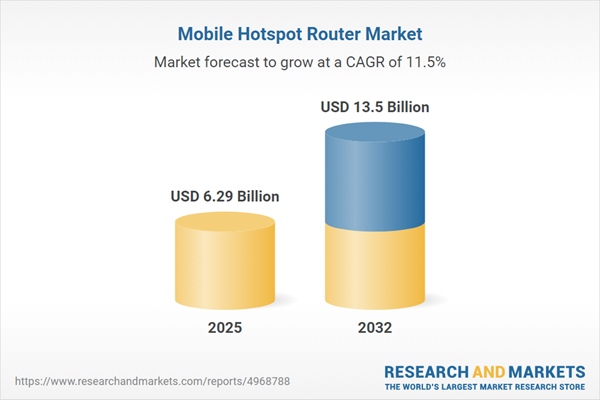Speak directly to the analyst to clarify any post sales queries you may have.
The mobile hotspot router market is enabling organizations to accelerate digital transformation, maintain operational stability, and support more flexible, resilient business models. Senior decision-makers look to these technologies for robust wireless agility, ensuring teams remain connected and productive in varied and changing environments.
Market Snapshot: Mobile Hotspot Router Market Trends and Growth
The global mobile hotspot router market is projected to reach USD 13.50 billion by 2032, rising from USD 5.63 billion in 2024 and USD 6.29 billion in 2025. This growth is supported by a compound annual growth rate (CAGR) of 11.53%. Market momentum is attributed to the widespread adoption of hybrid and remote work models, increasing use of Internet of Things (IoT) devices, and focused investments in advanced connectivity infrastructure. Enterprises are reevaluating their technology investments as they adapt to emerging wireless standards and shifting regulatory requirements, emphasizing responsive solutions that support continuity, innovation, and competitive performance.
Scope & Segmentation: Key Drivers in the Mobile Hotspot Router Market
The mobile hotspot router market serves enterprises and industries seeking secure, agile, and scalable connectivity solutions worldwide. Strategic segmentation helps address differing operational priorities, compliance obligations, and technology investments across regions and use cases.
- Connectivity Types: Includes Wi-Fi and Ethernet routers, available in both single and dual-band setups, offering stable access for enterprise, commercial, and industrial applications.
- Portability Options: Ranges from fixed indoor routers and rugged outdoor models to portable compact units and vehicle-mounted solutions, supporting coverage in offices, remote locations, and mobile deployments.
- Data Plan Structures: Offers bundled, standalone, prepaid, and postpaid models, each tailored to conventional business processes, high-traffic environments, or IoT-driven data needs.
- Distribution Channels: Encompasses direct sales, e-commerce platforms, authorized distributors, and telecom partnerships, allowing organizations timely access in target regions.
- Geographic Coverage: Addresses North America, South America, Europe, Asia-Pacific, Africa, and the Middle East, with each region presenting specific regulatory frameworks and connectivity requirements.
- Company Coverage: Market dynamics are influenced by leading manufacturers including Huawei Technologies, ZTE Corporation, NETGEAR, TP-Link, D-Link Corporation, Sierra Wireless, Inseego, Alcatel-Lucent Enterprise, Teltonika Networks, and Tenda Technology.
Tariff Impact: Navigating New U.S. Tariff Realities
Upcoming U.S. tariffs in 2025 have prompted providers to rethink sourcing, logistics, and procurement activities. As enterprises navigate cost controls and ensure a steady supply of devices, distributors refine their processes to limit exposure to additional tariffs. Buyers increasingly seek transparent, resilient, and well-managed supply chains, making adaptability and careful oversight essential for stable connectivity amid evolving regulations.
Key Takeaways: Strategic Insights for Senior Decision-Makers
- Mobile hotspot routers provide secure, scalable wireless networks, empowering distributed teams and enhancing collaboration across diverse organizational environments.
- Advanced wireless standards, IoT integration, and cloud-based capabilities drive real-time network visibility and robust security for enterprise workflows.
- Sourcing and procurement strategies are shifting toward environmentally responsible devices and stronger supplier partnerships aligned with internal ESG goals.
- Ecosystem collaboration among hardware vendors, software providers, and telecom operators accelerates the rollout of automated processes like predictive maintenance and continuous network monitoring.
- Enterprises operating across multiple regions emphasize flexible compliance and scalable IT infrastructure to reduce operational risks and ensure continuous service.
- Modern sourcing practices are designed to support agile responses to supply chain shifts and regulatory changes, reinforcing business continuity and growth objectives.
Methodology & Data Sources
This research is based on in-depth secondary research, expert industry interviews, and proprietary data modeling, delivering a comprehensive analysis of adoption trends, technology shifts, and geographic patterns in the mobile hotspot router sector.
The Mobile Hotspot Router Market: Why This Report Matters
- Senior decision-makers can align their wireless connectivity strategies with shifting regulatory environments, enabling improved risk oversight across operational regions.
- Access to reliable market intelligence supports informed capital allocation, portfolio optimization, and proactive supply chain risk mitigation.
- Structured frameworks empower organizations to design connectivity initiatives that enhance competitive standing and drive ongoing operational improvement.
Conclusion
By leveraging actionable market insights, organizations can refine sourcing, procurement, and risk management strategies to reinforce enterprise resilience and foster sustainable growth within an evolving marketplace.
Additional Product Information:
- Purchase of this report includes 1 year online access with quarterly updates.
- This report can be updated on request. Please contact our Customer Experience team using the Ask a Question widget on our website.
Table of Contents
3. Executive Summary
4. Market Overview
7. Cumulative Impact of Artificial Intelligence 2025
Companies Mentioned
The companies profiled in this Mobile Hotspot Router market report include:- Huawei Technologies Co., Ltd.
- ZTE Corporation
- NETGEAR, Inc.
- TP-Link Technologies Co., Ltd.
- D-Link Corporation
- Sierra Wireless, Inc.
- Inseego Corp.
- Alcatel-Lucent Enterprise SAS
- Teltonika Networks UAB
- Tenda Technology Co., Ltd.
Table Information
| Report Attribute | Details |
|---|---|
| No. of Pages | 180 |
| Published | October 2025 |
| Forecast Period | 2025 - 2032 |
| Estimated Market Value ( USD | $ 6.29 Billion |
| Forecasted Market Value ( USD | $ 13.5 Billion |
| Compound Annual Growth Rate | 11.5% |
| Regions Covered | Global |
| No. of Companies Mentioned | 11 |









